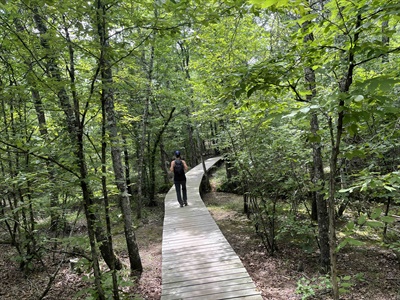Blue Mountain Natural Area is a 457-acre natural area near Little Rock in western Pulaski County.
“Blue Mountain is the western part of the Maumelle Pinnacles chain, which includes Pinnacle Mountain and Rattlesnake Ridge,” said Bill Holimon, agency director at the Arkansas Natural Heritage Commission. “The area was recognized by early naturalists, including the botanist Thomas Nuttall, who is credited with the popularity of the name “pinnacles'' and sketched the chain in his “A Journal of Travels into the Arkansas Territory during the Year 1819”. The Ouachita Sandstone Outcrop Barrens is a very rare habitat type occurring in just a few places in Arkansas and well protected at all three peaks of the Maumelle Pinnacles chain.”
The natural area is a partnership project of the Arkansas Natural Heritage Commission and The Nature Conservancy in Arkansas. It is part of a larger conservation corridor made up of nearby Rattlesnake Ridge Natural Area, Pinnacle Mountain State Park, the Maumelle River Wildlife Management Area and preserves of The Nature Conservancy.
“Blue Mountain is a typical shortleaf pine-oak woodland found in the Ouachitas,” said Douglas Zollner, director of science and strategy at The Nature Conservancy in Arkansas. “What is unusual are the sandstone ridges and the exposed bare rock that have a flora that more closely resembles Southwest Texas. Several plants endemic to the Ouachitas are found at Blue Mountain and a species of fern that is disjunct from its primary range in the Southwest, indicating that drier, more desert-like conditions occurred in this area historically. A couple of species, western diamondback rattlesnake and collared lizard, occurred up until the early 1990s but are no longer present.”
Visitors to Blue Mountain Natural Area have an outlet for outdoor activities like hiking, mountain biking and birding. A trailhead and a small parking area can be found along Highway 10. The trail system connects with trails at nearby Rattlesnake Ridge Natural Area. The small size of the parking area at the natural area is intentional. “We want to provide a nature-based experience,” said Zollner. “Restricting access allows for visitors to hike the trails without being crowded. Often, you will not meet anyone. It also keeps disturbance to the habitat and wildlife at a low level.”
There are three trails in the Blue Mountain Natural Area: the 3-mile multidirectional Luna Moth loop trail, a short mountain bike-only .8-mile single-directional route called Dhu Drop, and the 3.5-mile multidirectional Tarantula Hawk Trail, which connects to nearby Rattlesnake Ridge Natural Area. The combined trail systems of both natural areas provide terrain for all skill levels, although the trails at Rattlesnake Ridge Natural Area are a bit more advanced.
“A big focus for Blue Mountain is having more accessible beginner-friendly style of trails, “said Caleb Pierce, land steward with The Nature Conservancy in Arkansas. “It sees a lot more use, both by bike and in foot travel, for that reason.”
An opportunity to experience nature near Arkansas’ capital city is another draw of the natural area. “Though near a large urban area, this is truly an outdoor experience,” said Holimon. “Be sure to wear appropriate clothing and bring water, sunscreen, bug spray, and a hat when hiking Blue Mountain. Camping and campfires are not allowed. Like most natural areas, Blue Mountain does not have restroom facilities.”
The natural area also provides a connection point between nature and the outdoors.
“Blue Mountain Natural Area is close to Arkansas’ largest Metropolitan area and is open to the public for hiking, biking and just being in nature without the crowds,” said Zollner. “Many kids and adults are losing a connection with nature because they don’t have places to go. Take them to Blue Mountain or Rattlesnake to hike through open woodlands and just enjoy being outside.”
Blue Mountain Natural Area is one of many special places that can be found in the state that are under the care of the Arkansas Natural Heritage Commission as part of their System of Natural Areas. Currently, 79 natural areas across Arkansas protect key areas of high conservation and ecological importance. They are open to visitors and various parameters are in place, including limiting access to foot traffic on most, to help protect sensitive habitats and species. Since its creation in 1973, the Arkansas Natural Heritage Commission has worked with a number of partners, such as The Nature Conservancy, to help manage and protect these special places in Arkansas.
The Blue Mountain Natural Area is also part of the Maumelle Pinnacles Recreation Master Plan.
